About Aikido
 Aikido is a relatively new self-defense art, founded in Japan by Professor Morihei Ueshiba (1883-1969). As a youth, Ueshiba Sensei, or O-Sensei (Great Teacher) as he was called, applied himself to many arduous years of training in "Budo", or the Japanese martial arts. He was a master of Ju-Jitsu, the spear, and the staff, and was considered unbeatable with the sword. O-Sensei also delved deeply into religion and the meaning of life, studying Zen Buddhism and Shinto. Although he became very strong and won many matches, he was troubled with the idea that winning at someone else's expense was not truly winning. He came to realize that true self-defense was not winning over others - but WINNING OVER THE DISCORD WITHIN ONESELF. Though he was an acknowledged master, he began to practice movements, exploring them deeply, searching mentally, and sitting for long hours in mediation. As a result, Aikido was born as a way to divert harm from one's self while at the same time not inflicting permanent injury to an aggressor. As Aikido developed, it became clear that it was not only an effective means of self-defense, but a way to understand life through the study of energy flow of the universe..
Aikido is a relatively new self-defense art, founded in Japan by Professor Morihei Ueshiba (1883-1969). As a youth, Ueshiba Sensei, or O-Sensei (Great Teacher) as he was called, applied himself to many arduous years of training in "Budo", or the Japanese martial arts. He was a master of Ju-Jitsu, the spear, and the staff, and was considered unbeatable with the sword. O-Sensei also delved deeply into religion and the meaning of life, studying Zen Buddhism and Shinto. Although he became very strong and won many matches, he was troubled with the idea that winning at someone else's expense was not truly winning. He came to realize that true self-defense was not winning over others - but WINNING OVER THE DISCORD WITHIN ONESELF. Though he was an acknowledged master, he began to practice movements, exploring them deeply, searching mentally, and sitting for long hours in mediation. As a result, Aikido was born as a way to divert harm from one's self while at the same time not inflicting permanent injury to an aggressor. As Aikido developed, it became clear that it was not only an effective means of self-defense, but a way to understand life through the study of energy flow of the universe..
Saint John Aikido
Masamunkan History- Saint John Aikido came about as it was realized there was a need for an established dojo where students could go to practice and study the art of aikido in a friendly, non-competitive environment. The name “Masamunekan” comes from Date Masamune ( pronounced Datay )and “Kan” meaning – House. He was a famous Japanese warrior in the Edo Period. And, although he had only one eye, was very strong and ultimately faced seppuku ( cutting his own stomach ).
At the Masamunekan dojo, we practice the Yoshinkan style of Aikido. Ueshiba Sensei’s top student, Gozo Shioda, after receiving his 9th Dan, formed the Aikido Yoshinkai Foundation where the emphasis is on the study of the fundamental movements and solid basic techniques.
Yoshinkan Aikido, which means the “House of Cultivating Spirit or Mind”, also places emphasis on gaining philosophical insight into the conduct of life and human relationships.
The Yoshinkan style has become world recognized and is taught to the Tokyo Riot police in Japan.
Yoshinkan Aikido provides a very powerful means of self-defense without undue aggression.
Aikido holds that the mind and body are one. We need not struggle against an opponent’s strength. If we lead their mind, the body will follow. To lead, one must become calm, relaxed and in control of his or her own mind and body.
Meaning of the word "AIKIDO"
The word "AIKIDO" in Japanese is made up of three characters. The first is "AI", which means "to meet, to come together, to harmonize". The second character is "KI", which means "energy, spirit, mind". In a larger context, "KI" means "the spirit of the universe", and not just the spirit of human beings. The third and last character is "DO", which means "the way". It signifies that the study of Aikido does not involve merely self-defense techniques, but includes positive character-building ideals which a person can incorporate into his or her life. These three Japanese characters, "AI-KI-DO" therefore means: "THE WAY OF HARMONIZING WITH THE SPIRIT OF THE UNIVERSE" .
The Philosophy of Aikido
The most unusual aspect of Aikido is that although it is primarily a self-defense art, it takes as the basis of its philosophy the idea of being in HARMONY with your opponent rather than being in conflict with him. The idea of AIKIDO is not to think of defeating your enemy, but rather to be in harmony with him, spiritually, mentally, and physically. This is why Aikido is sometimes called the "ART OF NON-RESISTANCE", or the "NON-FIGHTING MARTIAL ART". Aikido is not merely an art of self-defense, however, into its techniques are woven elements of philosophy, psychology, body and energy dynamics. As one learns the various arts, he/she will at the same time training his/her mind, gain improvements in health, and develop self-confidence. Morihei Ueshiba envisioned a style that could be both non-aggressive and still be effective in a multitude of self-defense situations. From that vision came the art of Aikido. As a student, you will be taught to respect the body of your opponent. The techniques should never cause permanent damage. The pain you inflict will be momentary. The Aikido student is taught to search for eternal harmony. But his training has no end; for Aikidoists believe perfection of character is never complete.
Ethical Defence
Aikido is sometimes referred to as the "non-fighting art". Most experts agree that Aikido is the most ethical system of martial arts because of the basic principle of aiki (harmony) when dealing with an attack. Let's explain by using the following example: A man attempts to punch an innocent passerby in the stomach. What should be the defense used by the person attacked? Should he block the strike and attempt to break the person's arm in the process? Should he then smash the attacker's face, sweep him to the ground and kick the person until he is unconscious? On one end of the spectrum some people would even justify killing this person. According to the teachings of Master Ueshiba, the person who was attacked should defend himself without hurting the other person. The student in Aikido is taught to respect the body of his opponent. Although many of the techniques in Aikido are painful, the pain is momentary and should never create any permanent damage. Injuring your opponent is a sign of lack of control and still is certainly not a display of the highest level of ethics. A man's body (arms, legs, head, joints) has obvious structural limitations as to how far it can be twisted or bent before it will break. Aikido techniques are employed to neutralize the aggressor and not harm or seriously injure him. To do this requires that the Aikidoist have the highest ethical intention known to man - "love" - and "respect" for one another.
Ranking in Aikido
All beginners start as a white belt and after a series of testings, are graded through the kyu ranks until 1st kyu brown belt rank is achieved. After passing the black belt test he/she is awarded the rank of "SHO-DAN", (first degree black belt). A person holding a black belt rank (Yudansha) can also improve his/her standing from first degree to advanced "DAN" rank. Because of the nature of the Aikido philosophy, which promotes harmony and non-conflict, tournaments ("shiai") are non-existent, and instead well-executed performance of the arts (techniques) become the criteria for promotion. In addition, consideration is given to the character, attitude and understanding of the principles of Aikido, as well as the seriousness and diligence of the student during practice.
Leading and Blending
When executed properly, the techniques of Aikido do not result in using brute force or clashing with the power of the opponent. Aikido, in many instances, employs circular motion to contend with an attack coming head-on. The attack of the opponent is not stopped but is allowed to continue. The Aikidoist joins the power of the attack and then redirects this power harmlessly and harmoniously. Taking the attack and redirecting it is called "leading the opponent's energy or intention". Again, there should be no strain in the execution of techniques (especially in the upper body). The Aikidoist will let the opponent go where he wants to bend. Through the physical practice of the self-defense techniques, the student of Aikido comes to appreciate and understand the mental or spiritual aspect of Aikido. During Aikido practice, partners train in harmony with each other, learning when and how to yield, how to lead and guide another person's movements (how to defend themselves using non-resistive techniques). The student learns to position him/her in a solidly grounded triangle, keeping the center of gravity very low by relaxing the upper body, keeping the back straight, and breathing naturally. The power generated with natural breathing is called "Kokyo-ryoku" (breath-power) and is the essential power cultivated and strengthened in Aikido. Unlike pure muscle power, kokyu-ryoku does not deteriorate with age, but increases with one's understanding of Aikido, regardless of age, sex, or muscular strength for its effectiveness, one does not need to be physically large or strong to be effective in applying Aikido techniques. Aikido is therefore an effective martial art for both men and women.
Aikido Movements and Techniques
The movements of Aikido emphasize flowing, flexibility, timing, and the maintenance of balance. The aim of the Aikido practitioner is to purify him/herself and be in complete control of his/her mind and body, while keeping a calm, flexible and alert posture. Much of the beauty of Aikido movements comes from the coordinated motion of the entire body. Techniques include throws, immobilization, and joint flexing. Most of the joint techniques, such as those applied to the wrist or elbow, flex the joints in the direction of natural bending. They are in harmony with natural flexing, and although such techniques are effective and can be painful if resisted against, they result in no permanent damage to the joints. As the technique continues, the attacker is allowed to fall where he wants to fall - effortlessly and naturally. There is a limit to what you can accomplish with brute strength. If you stand on a railroad track and try to stop the train, you will, as we say in Aikido, become one with the tracks! Not a pleasant sight. It is much easier and effective to move off the track and blend with the trains power. In Aikido, much time is spent on getting "off the line" and not clashing or blocking as in other martial arts. It should not be a contest or power against power.






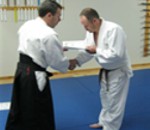
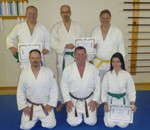

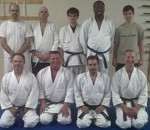
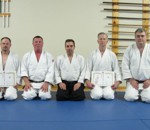


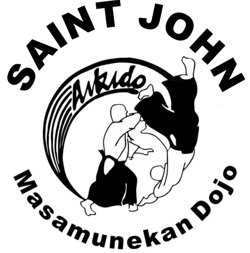 "All beginners start as a white belt and after a series of testings, are graded through the kyu ranks until 1st kyu brown belt rank is achieved".
"All beginners start as a white belt and after a series of testings, are graded through the kyu ranks until 1st kyu brown belt rank is achieved".